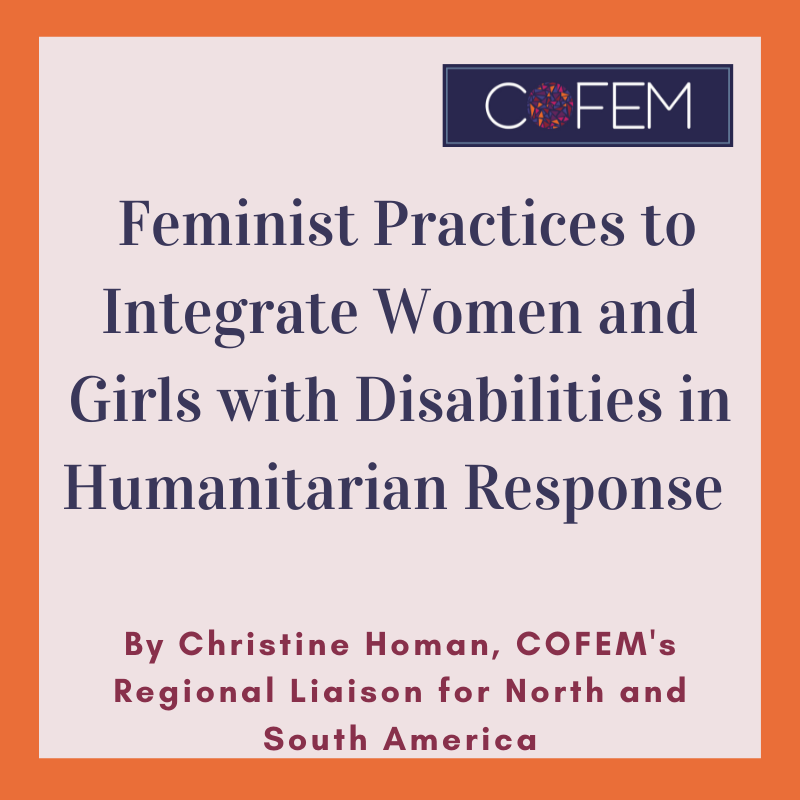Following on COFEM’s article about centering women and girls with disabilities in humanitarian crisis, here writer Christine Homan provides feminist practices to integrate women and girls with disabilities in humanitarian response.
Humanitarian crises come in many different forms, and have a deep impact on everyone affected, but it’s clear that women and girls with disabilities have unique needs in these situations that are not being met and make them more vulnerable to further exploitation and abuse.
According to a UNFPA Report: “Persons with disabilities are three times more likely to experience physical violence, sexual violence, and emotional violence than persons without disabilities. Women with disabilities in particular are up to 10 times more likely to experience sexual violence. Boys and men with disabilities are twice as likely as boys and men without disabilities to be sexually abused in their lifetime. In fact, estimates suggest that 40 percent to 68 percent of young women with disabilities will experience sexual violence before the age of 18.”
We know that women and girls with disabilities face additional risks for Gender-Based Violence (GBV) and mortality during times of conflict. The question now becomes, what can those responding to humanitarian crises do to mitigate these risks? And what does a feminist response look like?
While the best practices listed below need to be adapted to specific contexts, they are good starting points. It’s important to remember, including women and girls with disabilities does need to be complicated. Most of their asks are simply an extension of the work already being done. For example, most responses already attempt to enhance accessibility or language justice by including translation services. Tailoring responses to the specific needs of women and girls with disabilities and including sign language could be another kind of extension added to existing practice.
Best Practices
- Include women and girls with disabilities in decision making. They’re best positioned to articulate their needs in any given crisis. This will look different in each situation but can include: reserving spots for women with disabilities on leadership councils or creating a specific group for women with disabilities tasked with advising leaders. Unless space is intentionally made for these women, their voices are very likely to get lost.
-
When a WFP program in Pakistan revised its assessment and resource distribution policies to include gender and disability, it helped participants. One said, “Being fully engaged in the assessment process allowed her to inform [WFP Pakistan] about the barriers that she and her family are facing and the support that they require.”
-
- Ensure resources are accessible to those with disabilities. This means providing information in formats that are accessible, and making sure essential spaces like bathrooms are accessible to those with disabilities. Common spaces should also be included in this list, as places that should be made accessible to those with disabilities.
- Cash support can also help protect women and girls with disabilities. This group frequently faces precarious financial situations, and humanitarian crises exacerbate this. Supporting their financial security safeguards them from other forms of exploitation. This could come in many forms, including cash handouts and job support. This can also look like providing money to local organizations supporting women with disabilities.
- Recognize that disabilities come in many forms, not just physical, and provide appropriate support to those dealing with non-physical disabilities. This includes training those managing responses to recognize the different needs of women and girls with non-physical disabilities and give them the necessary resources to support them.
- Hold organizations accountable for providing support to women and girls with disabilities. Each organization tasked with responding to a humanitarian crisis should have a plan and resources in place that address the needs of women and girls with disabilities. In addition, these organizations need to be held accountable to the communities/populations they seek to serve for having these plans and resources in place , and implementing them. Donors especially should pay close attention to how an organization meets the needs of this population and be prepared to act accordingly. Organizations need to walk the walk, not just talk the talk.
Current responses to humanitarian crises do not meet the needs of people with disabilities in general, and especially do not meet the needs of women and girls with disabilities. Until they are actively prioritized in response planning and execution, they will continue to be the group that suffers the most in humanitarian settings.
By Christine Homan, COFEM Regional Liaison for North and South America.
You can read Christine’s previous blog on Centering Women and Girls with Disabilities in Humanitarian Crisis here.
